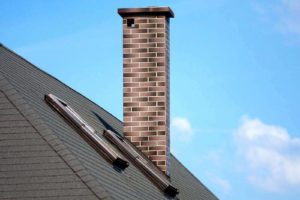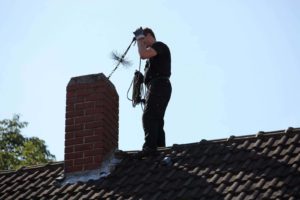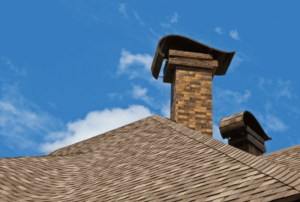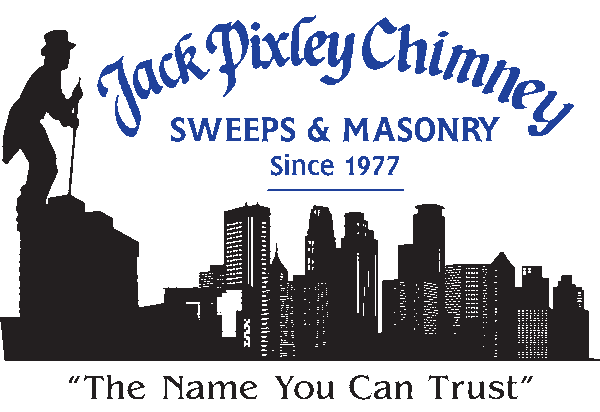A chimney inspection is an important diagnostic tool. Homeowners use Inspections to identify the cause of drafting issues. They also use chimney inspections to find damage in the flue liner and assess the structural stability of their chimney. At Jack Pixley Sweeps, we offer 3 levels of chimney inspections to ensure top efficiency and safety of your chimney system.
Three levels of chimney inspection
 In January 2000, the National Fire Protection Agency (NFPA) introduced three standardized levels of chimney inspection. This policy states that “Chimneys, fireplaces, and vents shall be inspected at least once a year for soundness, freedom from deposits, and correct clearances. Cleaning, maintenance, and repairs shall be done if necessary.” These standardized levels of chimney inspections help homeowners feel confident that their system is getting the proper care it needs.
In January 2000, the National Fire Protection Agency (NFPA) introduced three standardized levels of chimney inspection. This policy states that “Chimneys, fireplaces, and vents shall be inspected at least once a year for soundness, freedom from deposits, and correct clearances. Cleaning, maintenance, and repairs shall be done if necessary.” These standardized levels of chimney inspections help homeowners feel confident that their system is getting the proper care it needs.
Level 1 inspections
Level 1 chimney inspections are the most common type of inspection. We perform this level of inspection with regular chimney maintenance, or when your system is not experiencing any performance problems. During this inspection, we inspect all accessible portions of the interior and exterior of the chimney for signs of damage or deterioration.
Level 2 inspections
A level 2 chimney inspection is more intensive than level 1 inspection. In a level 2 chimney inspection, we provide an overview of the condition of the entire chimney system. We recommend level 2 chimney inspections for a new fireplace or insert installation, the relining of a chimney, or when you switched the fuel source in your system. You also need a level 2 inspection before buying or selling a home.
In the level 2 chimney inspections, we use closed-circuit cameras to view inaccessible portions of the chimney. This allows the chimney technician to view the entirety of the flue to check for cracks, damages, blockages, or other chimney issues.
Level 3 inspections
Level 3 chimney inspections are invasive. You only need this inspection if you suspect the structural stability of the chimney is in question. Typically, you will need this chimney inspection after a chimney fire, earthquake, tornado, or other natural disasters. We only use level 3 chimney inspections as a last resort, since this inspection involves removing part of the masonry or surrounding building materials such as bricks, walls, ceilings, siding.
The importance of chimney inspections
“A chimney inspection is like an annual dental check-up,” Director of Education for the CSIA Ashley Eldridge said. “It’s preventative maintenance that helps minimize potential hazards.” Chimney inspections are an important part of maintaining your chimney system. At Jack Pixley Sweeps, we meet all NFPA standards for chimney inspections. In addition, we use Chim-Scan camera systems as a part of all three levels of our chimney inspection.
A chimney inspection is an important diagnostic tool that can help identify the source of an odor. It also ensures your chimney is structurally sound and prepares your home to be sold. For more information on what type of chimney inspection your home need or to schedule your next chimney inspection, contact Jack Pixley Sweeps today!
Getting ready to sell your home is an difficult process. When a homeowner is ready to put their home on the market, hours are spent cleaning. However, there is one important place in your home that you should not overlook when cleaning – the fireplace.
If you are ready to sell your home, it is important to have a professional the fireplace and chimney sweeping and inspection. A Level II chimney inspection and report by a CSIA certified chimney sweep give potential buyers the peace of mind that the fireplace is in good condition. At Jack Pixley Sweep, all of our sweeps are CSIA certified and we have years of experience, you can trust our sweeps to put your mind at ease.
Have a professional chimney inspection before putting your home on the market
 In addition to packing boxes, staging furniture, and cleaning carpets, you should also schedule a Level II chimney inspection before putting your home on the market. Having your a chimney inspection before listing your house gives a full report of the actual state of your chimney with the disclosures of your home. More importantly, it gives homeowners a chance to make necessary repairs or changes to prevent delays during the transaction of a home.
In addition to packing boxes, staging furniture, and cleaning carpets, you should also schedule a Level II chimney inspection before putting your home on the market. Having your a chimney inspection before listing your house gives a full report of the actual state of your chimney with the disclosures of your home. More importantly, it gives homeowners a chance to make necessary repairs or changes to prevent delays during the transaction of a home.
Some of the most common problems discovered during an inspection are:
- Insufficient clearance between hot surfaces and nearby combustible materials
- Damage to the chimney liner or a liner that is the wrong size
- Flashing that has lost its watertight seal around the base of the chimney
- Moisture damage to the masonry
- Building techniques or components that are not compliant with modern safety standards and codes
What to expect during a Level II chimney inspection
During a Level I chimney inspection, which is performed during chimney maintenance, the sweep inspects all accessible interior and exterior of the fireplace. During a Level II chimney inspection, sweeps use technology such as closed circuit cameras to identify problems within the flue. Buyers may also request their own chimney inspection once the home is in escrow. This is done if there are more questions about the conditions of the fireplace, if an inspection was not done before the home was listed, or if the buyers doubt the findings of the original inspection.
Do I need a chimney inspection AND a home inspection?
Many homeowners and potential buyers believe that a home inspection spot any problems a fireplace has. While home inspectors usually identify major chimney problems such as structural instability, they often lack the training to thoroughly inspect a fireplace system. National Fire Protection Code 211 requires a chimney inspection before the sale of a home. An inspection by a certified chimney sweep can protect both the buyers and sellers during a real estate transaction.
Preparing to sell your home is stressful. having a professional chimney inspection before putting it on the market gives you and the potential buyers peace of mind. For more information on real estate chimney inspections, contact Jack Pixley Sweeps today!
Identifying issues with your firebox or the chimney structure can be easy, especially with chimney components that are accessible with visible damages. However, the flue, on the other hand, is a different story. With 15 feet – or more – of tight, enclosed flue between the firebox and chimney, it is nearly impossible to identify damage or chimney issues. Luckily, there is a technology that is made to reach this areas of the flue – closed circuit camera.
Closed circuit camera inspections
Closed circuit camera chimney inspections allows chimney sweeps to look at every part of your flue – without removing your masonry. This gives homeowners the peace of mind that there are no hidden dangers lurking in the flue after a thorough cleaning and inspection.
At Jack Pixley Sweeps, we use a closed circuit camera as a standard part of our inspections. This helps us identify any areas of damage or deterioration in the flue that cannot be otherwise seen. We ask that homeowners to be present during the video scan, as this allows them to see firsthand what is happening inside their chimney system.
When to schedule a closed circuit camera inspection
 Closed circuit camera scans are done as a standard part of our inspections at Jack Pixley Sweeps, as it is super beneficial in any circumstance. However, the following are three instances when it is beneficial to schedule a closed circuit camera inspection.
Closed circuit camera scans are done as a standard part of our inspections at Jack Pixley Sweeps, as it is super beneficial in any circumstance. However, the following are three instances when it is beneficial to schedule a closed circuit camera inspection.
- Buying a home – Buying a home is a major investment, you should protect your new home by getting a closed circuit camera inspection for all chimneys. Because this type of scan is rarely included in standard home inspections, it can help identify any hidden chimney issues.
- Selling a home – Give potential buyers peace of mind by having a closed circuit camera inspection before listing the home. A report from a certified chimney sweep gives potential buyers tangible proof to the condition of your chimney.
- After a natural disaster – After an earthquake, tornado, chimney fire, or natural disaster, it is important to have a closed circuit camera inspection before using your fireplace. This ensures that the fireplace is safe to use – or lets the chimney sweep know what repairs are needed.
A video inspection using closed circuit cameras is the best way to get a complete pictures of the exact condition of your entire chimney system. At Jack Pixley Sweeps, we are proud to offer this service to our customers; as long as our cameras fit in your flue! For more information on the benefits of closed circuit camera inspections or to schedule your next chimney appointment, contact us today!
Preparing to put your home on the market can be a stressful time. You must deep clean, fill out paper work, and work with a real estate agent or broker. However, it can be easy to look over one important selling feature in your home – your fireplace.
Fireplaces are one of the most sought after features in real estate and can add value to your home. The National Center for Real Estate Research found that “fireplaces have a strong, positive effect on selling price with each fireplace adding about 12 percent.”
However, potential buyers want to see that a fireplace is in good condition, ready to burn safely, and operate efficiently. To give potential buyers peace of mind and show off the condition of your home’s fireplace, invest in a Level 2 chimney inspection before putting your home on the market.
Chimney Inspections for Sellers – and Buyers
Home inspections are used to ascertain the value and condition of your home. However, many inspectors lack the expertise to effectively evaluate a fireplace system. Therefore, an outside chimney report can help protect both buyers and sellers.
Sellers can have the report from a Level 2 chimney inspection included in their documentation. This gives potential buyers information concerning the fireplace condition not covered during a standard home inspection. Likewise, buyers can also request an outside chimney inspection once under contact. This ensures there is no bias in the information provided about the fireplace system.
About Level 2 Chimney Inspections
The National Fire Protection Association (NFPA) created three standardized levels of chimney inspections. Level 1 chimney inspections are standard for regular annual maintenance, while Level 3 chimney inspections are used in case of serious damage or natural disaster.
Level 2 chimney inspections are used when buying or selling a home. This level of chimney inspection includes a comprehensive look at the condition of the entire chimney system – without being overly invasive or damaging the fireplace in any way.
During a Level 2 chimney inspection, the certified chimney technician will visually inspect all interior and exterior portions of the fireplace and chimney for signs of damage or deterioration. Inspections note anything affecting fireplace functionality or safety while recommending appropriate repairs.
Level 2 inspections also include the use of technology such as closed circuit cameras. This allows chimney technicians to view otherwise inaccessible portions of the flue, report on its condition, and identify otherwise hidden damage that could affect fireplace safety.
Buying or selling a home is stressful enough; don’t let the condition of your chimney add more fuel to the fire. Have a Level 2 chimney inspection to insure there are no hidden hazards or underlying damage in your fireplace system. If you are in the Minneapolis/St. Paul area, trust the experts at Jack Pixley Sweeps to perform a comprehensive inspection on your chimney. Contact us today to schedule an inspection before selling your home.
During the cold months of winter, homeowners rely on their fireplaces to work day in and day out in order to provide warmth and comfort in their homes. However, few us of truly understand the inner workings of our chimney and fireplace systems; because of this, small damage or performance problems may go unnoticed for months – or years – at a time.
Because few of us spend much time on our roofs or looking up the flue, chimney damage often goes unnoticed until a chimney inspection. A chimney inspection done by a certified chimney professional can assess the state of your fireplace system, identify areas of damage or deterioration, and allow recommendation for repairs to be made.
Levels of chimney inspection
The Chimney Safety Institute of America (CSIA)] and the National Fire Protection Agency (NFPA) created three standard levels of chimney inspections; the type of chimney inspection your home needs will depend on its condition, time since last maintenance, or performance problems it may be experiencing.
- Level 1: Level 1 chimney inspections are standard and all that is needed for most homes. During a Level 1 inspection, the chimney sweep will check the accessible interior and exterior portions of the fireplace and chimney for signs of damage or deterioration.
- Level 2: Level 2 chimney inspections are more in-depth, typically involving the use of technology such as closed-circuit cameras. Level 2 inspections are often recommended in real estate transactions or when the fuel source of a fireplace has been changed.
- Level 3: Level 3 chimney inspections are the most in-depth and only recommended when the structural stability of the chimney is in question, such as after a chimney fire or natural disaster. A portion of the masonry or walls may need to be removed during a Level 3 inspection.
Common issues uncovered in chimney inspections
- Every fireplace system and every chimney inspection are unique; however, there are a number of common issues that are often uncovered during an inspection. The following are three of the most common chimney issues uncovered during inspections.
- Water damage. Chimneys are built to withstand exposure to moisture, but it can still be extremely damaging to a fireplace system. Damaged chimney caps, cracks in the exterior masonry, or damaged flashing are just a few of the many ways water can get into a chimney.
- Cracked chimney crown. Chimney crown damage is extremely difficult to spot without climbing onto the roof or chimney. The flat masonry of the chimney crown bears the brunt of the exposure to the elements; changes in temperature or exposure to moisture can cause the chimney crown to crack over time.
- Damaged chimney liner. The chimney liner protects the surrounding building materials from heat transfer from the fireplace. Liners can become damaged from animal entry, leaks, lack of maintenance, or debris in the chimney.
Preventative maintenance is one of the best ways to extend the life of our fireplaces and chimneys. An annual chimney inspection done by a certified chimney professional can uncover hidden issues that many homeowners might not otherwise notice. For more information on the importance of chimney inspections or to schedule your next chimney appointment, contact Jack Pixley Sweeps today!
Fall’s cooler temperatures are just around the corner. This year, make sure your fireplace is ready to use by having your chimney inspected before your first fire.
What is a chimney inspection?
A chimney inspection is an important diagnostic tool that can be used to identify the cause of fireplace performance problems as well as assess the condition of everything from the firebox to the flue. Chimney inspections are an important part of regular annual fireplace maintenance and are helpful in finding areas of damage or deterioration before they turn into major problems.
According to the National Fire Protection Agency, or NFPA, “Chimneys, fireplaces, and vents shall be inspected at least once a year for soundness, freedom from deposits, and correct clearances. Cleaning, maintenance, and repairs shall be done if necessary.”
Three Levels of Chimney Inspections
NFPA Standard 211 created three standardized levels of chimney inspection. Your chimney sweep can help you determine which level of chimney inspection is best for your home based on use, condition, or performance problems.
- Level I: Level I chimney inspections are the standard level of inspection for homes with fireplace in good condition that have not been modified, damaged, or experienced performance problems. During a Level I inspection, the accessible interior and exterior portions of the chimney are checked for signs of damage or deterioration.
- Level II: Level II chimney inspections are more in-depth; inaccessible portions of the flue are checked using technology such as closed circuit cameras. Level II chimney inspections are often recommended when a home is being bought or sold. Likewise, they are also used when there have been changes to the fireplace such as changing fuel sources or installing a new insert.
- Level III: Level III chimney inspections are the most in depth – and invasive. Because of this, they are only recommended in cases of severe damage or structural instability after natural disasters such as earthquakes, fires, or tornadoes. During a Level III chimney inspection, portions of the masonry, walls, or ceilings around the fireplace and chimney may need to be removed in order to fully assess the damage.
The Importance of Annual Chimney Inspections
“A chimney inspection is like an annual dental check-up,” says Ashley Eldridge, Director of Education for the CSIA. “It’s preventative maintenance that helps minimize potential hazards.”
After a summer of disuse, it is important to have your chimney swept before using it for the first time. Debris, water, and animal entry can all create chimney problems during the spring and summer; while these issues are often quickly recognized when the fireplace is being regularly used, they may have gone unnoticed during the summer. An inspection can identify these issues and allow them to be repaired – without causing further problems or damage to the chimney.
Make sure your chimney is ready for the first fire of the season by having it inspected. Contact Jack Pixley Sweeps today to schedule your fall chimney inspection and get your fireplace ready for fall.
 In January 2000, the National Fire Protection Agency (NFPA) introduced three standardized levels of chimney inspection. This policy states that “Chimneys, fireplaces, and vents shall be inspected at least once a year for soundness, freedom from deposits, and correct clearances. Cleaning, maintenance, and repairs shall be done if necessary.” These standardized levels of chimney inspections help homeowners feel confident that their system is getting the proper care it needs.
In January 2000, the National Fire Protection Agency (NFPA) introduced three standardized levels of chimney inspection. This policy states that “Chimneys, fireplaces, and vents shall be inspected at least once a year for soundness, freedom from deposits, and correct clearances. Cleaning, maintenance, and repairs shall be done if necessary.” These standardized levels of chimney inspections help homeowners feel confident that their system is getting the proper care it needs.
 In addition to packing boxes, staging furniture, and cleaning carpets, you should also schedule a Level II chimney inspection before putting your home on the market. Having your a chimney inspection before listing your house gives a full report of the actual state of your chimney with the disclosures of your home. More importantly, it gives homeowners a chance to make necessary repairs or changes to prevent delays during the transaction of a home.
In addition to packing boxes, staging furniture, and cleaning carpets, you should also schedule a Level II chimney inspection before putting your home on the market. Having your a chimney inspection before listing your house gives a full report of the actual state of your chimney with the disclosures of your home. More importantly, it gives homeowners a chance to make necessary repairs or changes to prevent delays during the transaction of a home. Closed circuit camera scans are done as a standard part of our inspections at Jack Pixley Sweeps, as it is super beneficial in any circumstance. However, the following are three instances when it is beneficial to schedule a closed circuit camera inspection.
Closed circuit camera scans are done as a standard part of our inspections at Jack Pixley Sweeps, as it is super beneficial in any circumstance. However, the following are three instances when it is beneficial to schedule a closed circuit camera inspection.